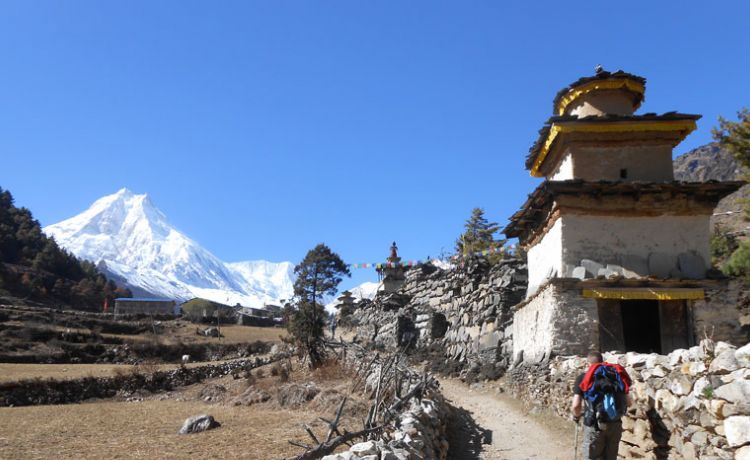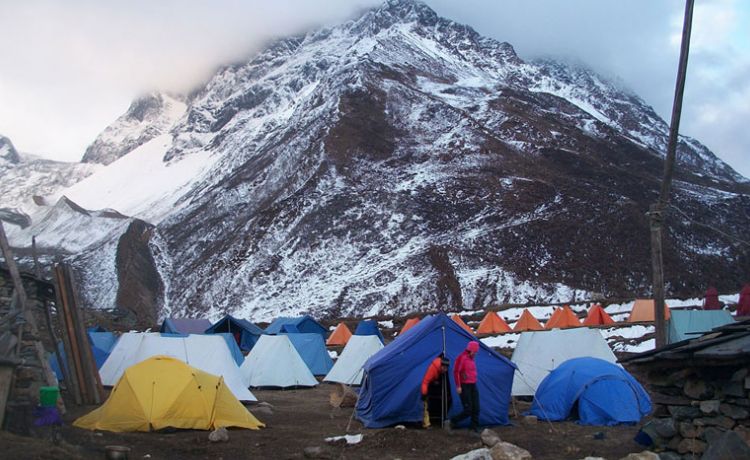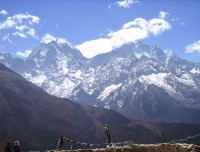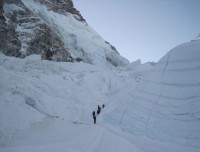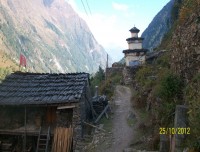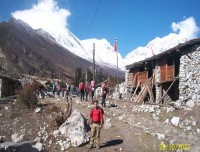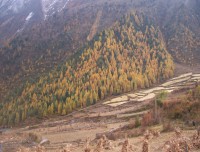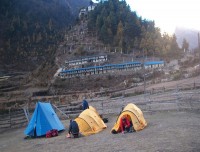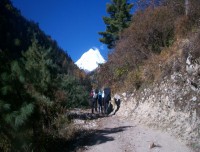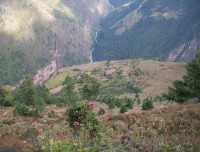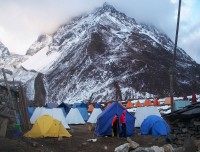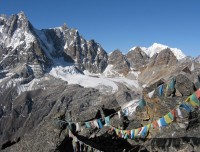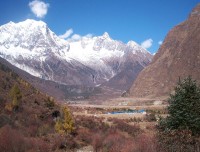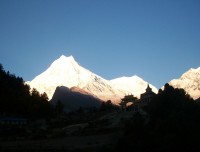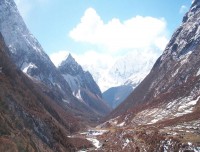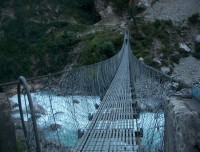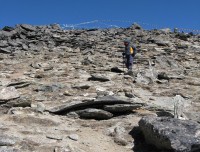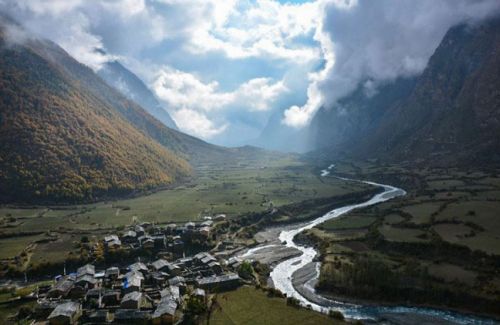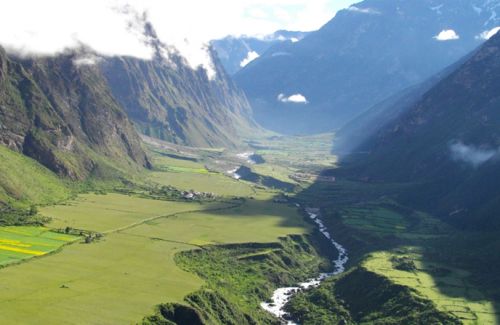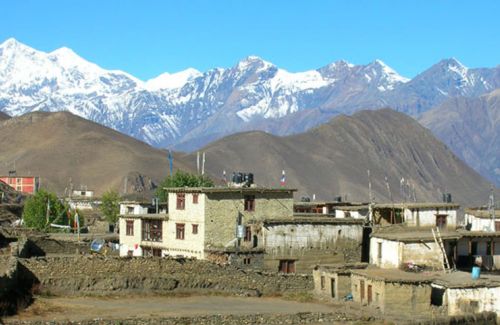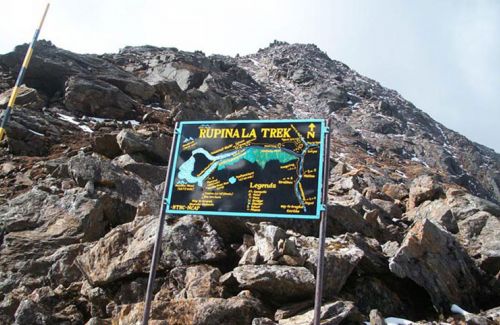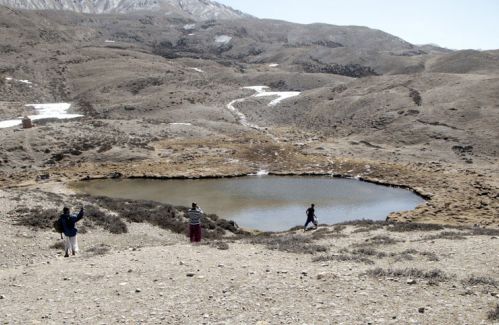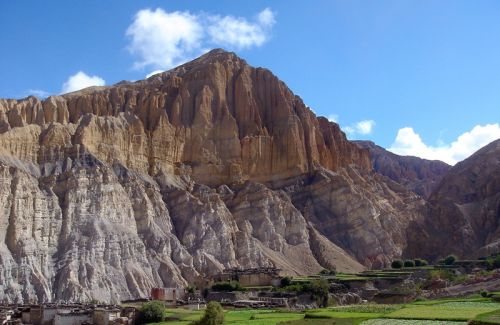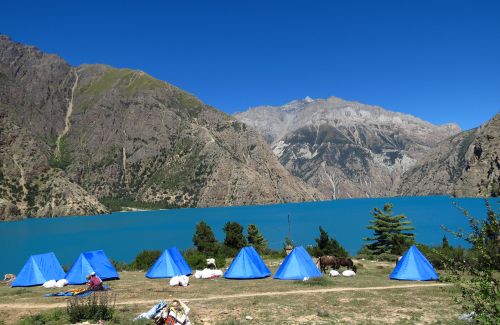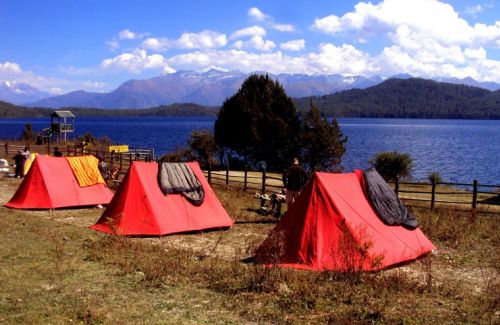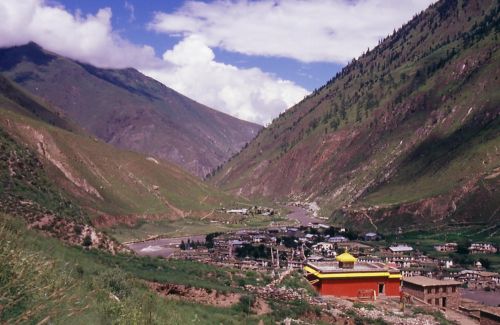Manaslu Circuit Trekking
- Duration20 Days
- Max. Altitude4,460 m
- Starts FromUSD 1980
Destination:Nepal
Trip Grade:Strenuous (****)
Meals:Breakfast + Lunch + Dinner
Transportation:Public Vehicle
Accommodation:Lodge
Trekking Region:Manaslu Region
Show All
Manaslu Circuit Trekking focuses in wilderness and an authentic village experiences.Trek Manaslu Circuit wraps around mount Manaslu, the world’s eighth highest peak, looming at 26,759 ft. Manaslu Circuit Trek begins by climbing against the current of the Budhi Gandaki River for nearly three vertical miles. The path sweeps through gorges where glaciers hang and drain the frozen eaves of the planet. We cross the suspension bridges and passes through fields of barley, as it follows an ancient route along which caravans of yaks hauling salt from Tibet, have traveled for thousands of years. Climbing higher to the last clusters of homes before the mountain wall of Himalaya, we step into Tibetan territory. Architecture matches these ethnic lines and as altitude rises, so does the number of monasteries, Mani walls and Chortens.
From here, the trail crosses the legendary land of Gorkha where herder’s huts lay tucked high in the thawing meadows. Close to a dozen peaks over 21,000 ft. serrate the horizon as the path rises to Larkya La Pass, the highest point of the hike at 17,175 ft. at 10 hours bus drive from Kathmandu deposits us to Aarughat Bazaar (1,893 ft). From Aarughat, it is possible to hire a jeep to transport to Sothikhola. We can connect this trek to Annapurna circuit.
The major trekking seasons are from March to May and September to the November. This is due to the monsoon season, a period of relentless rain that drowns the region from June through August. The frigid Himalayan winter also makes visiting Manaslu region miserable, if not impossible, during the early months of the year. For this reason, more than half of the annual 2,000 visitors to Manaslu make their pilgrimage in October.
Manaslu Conservation Area is considered restricted by the national trust for nature conservation - the same agency responsible for Annapurna which requires an additional permit and accompaniment of the registered guide. Be reminded that this additional hassle is what keeps Manaslu from becoming Annapurna, and is well worth the extra fee.
Trip Highlights
- Sightseeing in Historical Monuments in Kathmandu.
- Scenic drive from Kathmandu to Aarughat
- Drive back to Kathmandu from Beshishahar
- Breathtaking view of Manaslu and Annapurna ranges
- Get refresh in natural hot spring shower
- Experiencing the different ethnic communities and their life style
Day to Day Itinerary
Day 01:Arrival at Tribhuvan International Airport (1,350 m) & Transfer to Hotel.Overnight at Hotel
Day 02:Sightseeing at Historical Monuments in Kathmandu and Trek Preparation. O/N at Hotel
Day 03:Drive from Kathmandu to Aarughat Bazaar (570 m), 7 hrs. O/N at Guest House
Day 04:Trek from Aarughat to Sotikhola (730 m), 6 hrs. O/N at Guest House
Day 05:Trek from Sotikhola to Machhakhola (930 m), 6 hrs. O/N at Guest House
Day 06:Trek from Machhakhola to Dovan (1,070 m), 5 hrs. O/N at Guest House
Day 07:Trek from Dovan to Philim (1,570 m), 5 hrs. O/N at Guest House
Day 08:Trek from Philim to Deng (1,860 m), 6 hrs. O/N at Guest House
Day 09:Trek from Deng to Namrung (2,540 m), 7 hrs. O/N at Guest House
Day 10:Trek from Namrung to Lho (3,020 m), 5 hrs. O/N at Guest House
Day 11:Trek from Lho to Samagaun (3,390 m), 4 hrs. O/N at Guest House
Day 12:Acclimatization Day at Samagaun. O/N at Guest House
Day 13:Trek from Samagaun to Samdo (3,690 m), 3 hrs. O/N at Guest House
Day 14:Trek from Samdo to Dharamshala (4,460 m), 3.5hrs. O/N at Guest House
Day 15:Trek from Dharamshala to Bhimthang (3,590 m), 8-9 hrs. O/N at Guest House
Day 16:Trek from Bhimthang to Tilije (2,300 m), 6.5 hrs. O/N at Guest House
Day 17:Trek from Tilije to Jagat (1,300 m), 6 hrs. O/N at Guest House
Day 18:Trek from Jagat to Beshishahar (760 m), 5 hrs. O/N at Guest House
Day 19:Drive from Bashisahar to Kathmandu (1,350 m), 8 hrs. O/N at Hotel
Day 20:Transfer to the International Airport
Cost Include
- Airport picks up & drop by private tourist
- 3 nights’ twin sharing 2-3 star hotels in Kathmandu with Breakfast
- Guided city tour in Kathmandu by private tourist vehicle
- Full board meals (Breakfast + Lunch + Dinner) during the trek
- Guest Houses, Lodges basis accommodation during the trek
- Professional license holder English speaking guide
- The required number of local staff and porters (2 Trekkers = 1 Porter)
- Food, accommodation, salary, insurance, equipment and medicine for all staff
- Manaslu Conservation Area permit and Special permit for Manaslu Circuit trekking
- TIMS Card and Restricted Area Entry Permit for Manaslu Circuit Trekking
- Down Jacket, Duffel bag and sleeping bag by Himkala Adventure if required
- All necessary equipment for the tented camping
- Drive from Kathmandu to Aarughat by public bus
- Drive from Beshishahar to Kathmandu by public bus
- Farewell dinner in traditional Nepali restaurant with cultural show
- All our government taxes, vat & service charges
Cost Exclude
- Lunch and dinner in Kathmandu
- Entrance fee in all monuments during tour
- Emergency rescue and evacuation cost
- Your travel insurance
- Nepal entry visa fee which is issued in Kathmandu Airport
- Your personal expenses like phone bills, hot shower, battery recharge, laundry bar bills etc
- Personal trekking equipment
- Tips for trekking, tour staff and driver (Tipping is expected)
- Any others expenses which are not mentioned on ‘Cost Includes' section
Detail Itinerary
Day 01Arrival at Tribhuvan International Airport (1,350 m) & Transfer to Hotel.Overnight at HotelUpon your arrival at Tribhuvan International Airport in Kathmandu, our representative from Himkala Adventure heartily greets you and transfers you to the hotel in Thamel, the touristic area. After check in hotel, you could take rest or stroll around Thamel and see the local markets. Overnight in Kathmandu
Day 02Sightseeing at Historical Monuments in Kathmandu and Trek Preparation. O/N at Hotel After breakfast, we begin our day tour and leave the hotel around 9 am. We visit Swoyambhu Stupa, affectionately called it the monkey temple. This is the old stupa built in 6th century, situated in the conical shaped hill, 77 m high from the ground level. We walk around the stupa and visit 7 puras, monasteries, descend to the Kathmandu Durbar Square. This is the place where we can see the palace built in 18th century, a museum, courtyards and many Hindu temples. After the sightseeing of this area, we move towards Boudha Stupa which is about 8 km far from Kathmandu city center. This is the biggest stupa in the southern Asia, in typical Nepali architecture. There are many monasteries around. The fourth place for today is Pashupatinath – the Shiva Temple. There are number of temples with Shiva Lingams. The holy river Bagmati is flowing and the golden roofed temple is residing on the bank of this river. There are many platforms for the cremation. After this, we return back to hotel. We give you the briefing about the Lower Manaslu Trek that we begin from tomorrow. Overnight at Kathmandu
Day 03Drive from Kathmandu to Aarughat Bazaar (570 m), 7 hrs. O/N at Guest House We drive from Kathmandu to Aarughat Bazaar in Gorkha District. It is 125.6 km from Kathmandu, the short cut route by Prithivi Highway through Dhading Benshi. After Dhading Benshi,it is rough road does have the jerky movement but the scene view around is memorable. Overnight at Aarughat
Day 04Trek from Aarughat to Sotikhola (730 m), 6 hrs. O/N at Guest House After breakfast, we set out from Aarughat to Sotikhola. It is perfect path through rice fields ascending to Gurung settlements. From Shanti Bazaar, we can view the Shringi Himal and the clear glacier that blends into the Budhi Gandaki River. After we cross the suspension bridge and arrive at Soti Khola. Overnight at Sotikhola
Day 05Trek from Sotikhola to Machhakhola (930 m), 6 hrs. O/N at Guest House Today, we follow the trail through forest and pass the lovely settlements of Liding and Lapubenshi. The trail continues to Machhakhola. Overnight at Machhakhola
Day 06Trek from Machhakhola to Dovan (1,070 m), 5 hrs. O/N at Guest House After breakfast, we walk through the fluctuating trail, rising and falling then we cross streams, pass the precipitous gorges and reach to Khorla Benshi. We can have lunch there and cross the suspension bridge to the eastern bank and arrive at Dovan. Overnight at Dovan
Day 07Trek from Dovan to Philim (1,570 m), 5 hrs. O/N at Guest House Being energetic, we traverse the rocky trail and reach to Yara Khola. We cross the suspension bridge and arrive at Jagat from where we enter into the Manaslu Conservation Area. The lustrous view of Shringi Himal looms ahead. Then, the trail gradually ascend towards the bridge and reaches to Philim. Overnight at Philim
Day 08Trek from Philim to Deng (1,860 m), 6 hrs. O/N at Guest House After breakfast, we cross the Budhi Gandaki River; the trail goes through the cliff, down to the Shar Khola which conbines to Budhi Gandaki. The trail then flattens, passes through the bamboo forest. We encounter the people Tibetan and Gurung, mostly the farmers and shepherds. Overnight at Deng
Day 09Trek from Deng to Namrung (2,540 m), 7 hrs. O/N at Guest House After having breakfast, we leave Deng and follow the course of Budhi Gandaki. We cross the river and follow the trail uphill to Rana. We pass the little monastery and cross the suspension bridge over Shringi Khola. We take our lunch at Ghap. After lunch, we head towards the north and to the west through the dense forest. We steeply climb until we reach to Namrung. Overnight at Namrung
Day 10Trek from Namrung to Lho (3,020 m), 5 hrs. O/N at Guest House Trek from Namrung to Lho begins climbing alongside a Mani wall through fields. We pass the village of Barchham then Lihi and climb to Sho Village – another cluster of stone houses. We find there is Much more Tibetan influence closely packed stone houses standing together and sharing common flat roof and courtyard. After we pass the gorge, we enter to Lho, an important village with a monastery and Lama School. Overnight at Lho
Day 11Trek from Lho to Samagaun (3,390 m), 4 hrs. O/N at Guest House We descend down and cross the Thusang Khola. We then follow the ancient trans-Himalayan trail across the glacier fed Numla Khola where the valley drops away to a moraine. We arrive at the region where there is a classic Lama settlement with monastery, Mani walls and Tibetan Practices. Overnight at Samagaun
Day 12Acclimatization Day at Samagaun. O/N at Guest House Samagaun is very Tibetan like with yaks grazing and many horses roaming around. The multi-layered mani stone structure at the east end of the village is unlike any other encountered in Nepal. The village itself is a tightly knit structure, rows of houses built one next to the other, and the cobble- stone walkways passing by people’s courtyards provides a wonderful introduction to the town. The gompa or a monastery at the far end of the valley is well worth a visit. So, we can hike to Pung-gyen Gompa. Overnight at Samagaun
Day 13Trek from Samagaun to Samdo (3,690 m), 3 hrs. O/N at Guest House After breakfast, we follow the trailwide open river bed over much stone and sand. As we near to Samdo, we keep on the lookout for “Himalayan Mussa” or Himalayan Marmot which are abundant here. Samdo is another Tibetan like village of winding walkways and snugly built shelters. The people here are very friendly. Signs of trade with Tibet are everywhere; yak caravans thunder by and windblown horse riders plow down the trails with fearless speed. Overnight at Samdo
Day 14Trek from Samdo to Dharamshala (4,460 m), 3.5hrs. O/N at Guest House Today, after breakfast, we cross the small wooden bridge over the Budhi Gandaki River. Then it is a steep trail winding around with views looking down on the remains of Larkya Bazaar. After 3 hours walk, we reach to the final campsite before the pass, Phedi (Base Camp) or Duwang (4,450 m). There are no lodges around Dharamshala. Either we have to camp or continue to trek to Bhimthang. From Samdo to Bhimthang will be a very long and tiring trek of about 11 hours. Overnight at Phedi or Duwang or Dharamshala
Day 15Trek from Dharamshala to Bhimthang (3,590 m), 8-9 hrs. O/N at Guest House An early morning start is required to gain the pass. This often means beginning to walk with head lamps in very early morning hours. At times, there is no visible trail-an experienced guide is essential to keep the group together and to select the efficient route. Passing by a large frozen lake, the colorful prayer flags and small chorten marking the Larkya La (5,250 m) at last becomes visible – a truly remarkable site between rock and sky. Descending the pass is not an easy task and it is the very steep trail cuts down over rock and scree, strong quadriceps and sturdy walking stick are required. We finally arrive at Bhimthang . Overnight at Bhimthang
Day 16Trek from Bhimthang to Tilije (2,300 m), 6.5 hrs. O/N at Guest House Today, we descend through meadows of Bimthang and cross the Himlun glacier and a bit of scrambling across the rubble which has been pushed on the top. Continuing the drop, the trail enters a tranquil pine and rhododendron forest with frequent clearings affording excellent views back to Manaslu.
The trail meanders and twists down through forest until the quick approach leads back to rice terraced fields and farm land once again. The Gurung village of Tilijet is a charming place for the overnight stay. Overnight at Tilije
Day 17Trek from Tilije to Jagat (1,300 m), 6 hrs. O/N at Guest House From Tilije, we descend down and away from the snow peaks toward another cultural contrast. We arrive at the confluence of Dudh Khola and Marshyangdi which crosses to the west side of the Marshyangdi and now joins the sper highway of the Manaslu Circuit. We ultimately arrive at Jagat which boasts hot springs for tired, sore legs and several ridge top restaurants that offers fine ridgeline views. Overnight at Jagat
Day 18Trek from Jagat to Beshishahar (760 m), 5 hrs. O/N at Guest House The trail on to Beshishahar, the road head of this area, finds the river canyon opening up and flattening out. Last hours on the trek are spent walking through the quiet heat of rice terraces where naturally the mind meanders back to memories of brilliant snow peaks and cold weather of the high altitude pass. Overnight at Beshishahar
Day 19Drive from Bashisahar to Kathmandu (1,350 m), 8 hrs. O/N at Hotel Today, we drive from Beshishahar to Kathmandu. It is 177 km east from Beshishahar and takes about 8 hours by bus. The scenic beauty of rural side following the Marshyangdi River and Trishuli piercing the hills by the Prithivi highway is pleasant journey. After arrival in Kathmandu, we are transferred to the hotel and join for the dinner arranged by the Himkala Adventure with Nepalese cultural show in the typical Nepalese restaurant. Overnight at hotel in Kathmandu
Day 20Transfer to the International Airport We depart you to the International Airport 3 hours before to your scheduled flight. If you have enough time, you could go for shopping in the local market around Asan, Indrachowk, and the dainty gifts to your family members, relatives and friends. We finally depart you to the airport. We are very much obliged to you that you joined Himkala Adventure for the trek to Manaslu Circuit Trekking. Hope to see you again and we wish you to have safe journey to your onward destination. Namaste!!!
Trip FAQ
Himkala Adventure would like to answer all the queries about Manaslu Circuit Trekking for all curious travelers/trekkers in the world. As you are entirely from different geographical location, you could better to know everything about the treks from the beginning i.e. airport pick up till your departure like airport picks up, drops off, accommodation in city, in the trek, guide and porters, safety for the trekking, food and accommodation and some other things that you might face on the way. Hope our endeavor listing these questions answers will help you self informed.
This is simply the outlines of the services we offer but it may differ as per your requirement, number of trekkers. What we go through our conversation, we will manage the means of transportation, hotels in the city, accommodation in the trekking, numbers of porters etc. This is general idea about Mansalu Circuit Trekking before your trip and you become clearer about the trek. Please feel free to contact us to get more information about the trekking in the Himalayas of Nepal.
1) How is Manslu Circuit Trekking in Nepal?
Manaslu Circuit Trekking is the 10th famous trekking trail in the world. Despite more traffic on the way and the the trail cut through into many places by modern roads, it is still fascinating.The trail offers the magnificent views of Mt. Manaslu (8163m), the eight tallest mountain in the world, coupled with a chance to witness the rich local heritage and biological diversity of the region. The highest point in this trek is the ‘Larkya La Pass’ which is widely believed to be one of the most dramatic pass crossing the Himalayas.
2) What physical fitness do I need to book this trip?
Every trekking in the Himalayas of Nepal requires the certain level of physical and mental fitness. So, we advise you to be in good physical shape and able to feel comfortable while hiking up and down 7 to 12 miles per day on a trail carrying a day pack of about 10 pounds. Three things could make you confident enough for any trek you would like to do: aerobic, strength and mental.
Aerobic conditioning is important primarily because you will be trekking in thinner air, up to 40% less than at sea level. With good aerobic conditioning, you will be able to better metabolize whatever oxygen is available to you. You should plan on doing at least one hour of aerobic 3 /4 times per week for 1 month or more before your arrival in Nepal. Walking, jogging, cycling, hiking on floor to ridge line ascents with day back are some of the excellent forms of exercise, so long as you are strengthening leg muscles and building stamina. Speed is not the essence; stamina, confidence and continuity are. Do as much uphill as possible. If you live in flat area, go to the stadium and use the steps with your pack.
3) Do I really need to use guide to Manaslu Circuit Trekking?
You are advised to use Guide so that you could feel safer in the unknown area because the guide can tell you the possible danger as they have guided in this region since long. Most importantly, the Himalayan weather is really unpredictable and the Guide can help you to take proper shelter. Nest advantage to be with Guide is you get more knowledge about local culture and you could have easy access to interact with the local people. In 2014, the Nepal Government clearly has stated that the trekkers should have a guide but still it is not seemed in the practicality.
4) How do I find Himkala Adventure for my pick up at the airport?
Our representative from Himkala Adventure will display a small board (placard) of company or your name outside the airport terminal. You will be driven to the hotel by our tourist vehicle.
5) What sort of accommodation do I get in Kathmandu?
Normally we provide standard rooms with twin sharing accommodations at three star or similar category hotels in Kathmandu including breakfast. Accommodation in these cities can be upgraded as per your request. But some of our packages are sold without accommodation in the city.
6) How are tea house facilities during Manaslu Circuit Trekking?
Tea House is the combination of guest house, restaurant, and social hang out. Tea houses in Manaslu Circuit Trekking area are professional though they are simple but with neat and clean lodging offering fine views and plain but fresh and hygienic food with friendly atmosphere Most of the Tea Houses have running water facility. Many of them have hot water available for bathing. But we discourage our groups from using water heated by wood as lack of firewood in most villages is a big environmental concern in Nepal.
7) What sort of accommodation do I get in trekking?
Guesthouses/Tea Houses/Lodges provide twin sharing single and double rooms and occasionally a dormitory which is basically clean with a mattress and a quilt or blanket. Our company provides the sleeping bag if needed but we always recommend having your own sleeping equipments. You have to share the room with your group member or sometimes with unknown traveler. The toilet is always outside the room with basic facilities.
8) What sort of foods, water and drinks can I expect in trekking?
The foods in the Himalayas are very simple. There are mostly the family members themselves to cook and serve the meal. They are simply trained but experienced because they have been offering such services for many years in this busy route. The food is hygienic, fresh and delicious. We recommend you to drink mineral water or the boiled or using water purification pills or drops.
Most of the foods are cooked in the kitchen of tea houses. They serve you with different varieties of delicious Nepali and continental dishes. The most popular Nepali food is daal bhat (rice and lentils) with some mixed vegetable curry. Garlic soup is popular as it helps you with acclimatization. You could better be vegetarian in the mountains. All hotels in cities and guesthouses in trekking serve the vegetarian food. You can find all common types of drinks like hot chocolates, coffee, tea, hot lemon with honey, ginger tea, soft drinks etc. you will have your breakfast and dinner at the lodges where you will be staying and lunch somewhere on the way to your next destination.
9) What mode of transportation do I use?
We will provide the private transportation for Airport/Hotel/Airport pick up and drop and sightseeing in Kathmandu Valley. We use transportation as based on our cost inclusion section. The transportation varies depending on your requirements at the time of booking the trip.
10) What is the best season for this trekking?
The best season for Manaslu Circuit Trekking is spring (March to May) and autumn (September to December). These are the perfect time of the year for the breathtaking views of Himalayas with clear and sunny days. But the weather in the mountains is unpredictable.
11) What is the weather and temperature like during the trekking?
The climate in Nepal varies from place to place which can be categorized in different four main seasons. The main seasons in Nepal are spring (March to May), summer (June to August), autumn (September to November) & winter (December to February). The best season to travel in Nepal is autumn (September, October & November) & spring (March, April & May). Weather in the mountains is unpredictable. But the day temperature in Manaslu Circuit Trekking is comfortable.
12) Who will be guiding me during this trip?
We provide the professional government license holder English speaking trekking guides for our entire trekking trip. We can also provide French, Spanish, Japanese, German or Italian speaking guides as per your preference with extra payment but not guaranteed. All guides will be Nepali people who are carefully selected on the basis of their appropriate experience, leadership skills and personality. They are all trained from Nepal Academy of Tourism and Hotel Management, certified and approved by the Tourism Department of Nepal government. We provide a different city tour guide to guide you in UNESCO World Heritage Sites in Kathmandu. They are the professional license holder guide specialized in culture, history, geography, iconography, archeology and religion with good command over English. Tour guides are specialized in city tour and trekking guides are more in the hiking and trekking in the Himalayas.
13) What sort of experience do your guides have?
Our entire city tour guides have bachelors to Master Degree academic education along with many months tour guiding training from Nepal Academy of Tourism and Hotel Management, Rabi Bhawan, Kathmandu, Nepal. They are fluent in spoken languages and informative about the sites in many aspects. They are quite experienced and dedicated to their job and responsibilities.
Our entire trekking guides have minimum Intermediate to Master Degree academic education with trekking guide training from Nepal Academy of Tourism and Hotel Management, Rabi Bhawan, Kathmandu, Nepal. Many of them are from villages. As they are local, they know more about the routes, necessary precaution to be taken and so on. They have spent many years exploring many parts of the country. They are trained in first aid and able to handle any situation easily. They speak good English and make you know about the places you visit.
14) May I charge my electronic gadgets during Manaslu Circuit trekking?
Most of the places in your tea houses have charging facilities. You can charge your devices by paying some extra money. It’s good if you bring TWO or THREE pin travel adapter and put your gadgets at warm place at night.
15) How much additional money is required for this trip?
It’s a very personal question as expenses depend on habit. Normally, in Kathmandu you can allocate about USD 10 to 15 per person per lunch or dinner. USD 10 to USD 15 per person per day will be sufficient to buy bottles of water, chocolates, pay for a hot shower during the trekking. Other personal expenses will be your own calculation.
16) What is the social and environmental responsibility of Himkala Adventure for this trip?
The situation of environment in Nepal is in considerable stage due to so many factors caused by global warming, human activities, and adverse effects of natural incidents. Nepal is in between two giant countries like China and Nepal. The ozone layer is depleting and the atmosphere is getting heated. So, its direct effect is to the Himalayas that the snow is melting day by day and the sea level is rising. It is due to population growth, people are clearing the forest and the soil is being eroded. As a part of society, and our trekking related activities are directly concerned with the social and environmental things. We are very conscious not litter in the open spaces, to manage garbage properly and make local people aware in this campaign. We are working together with other companies and taking these issues seriously.
17) What is the minimum number requirement for this trip?
We operate individual trip to the group joining trips for Manaslu Circuit Trekking. If you want to do any private trip we are ready to organize for solo traveler as well with some additional charges.
18) Are there communication or internet services during Manaslu Circuit Trekking?
All our guides carry the local mobile phone. You can use his mobile phone to make any local or international call from trekking trails by paying him directly. You can even pass him number to be connected with your family or friends. We highly recommend taking local SIM card for call and internet services during trekking. Local SIM cards are easily available in many stores and at airport as well. You need to provide two copies of your photographs and your passport copy to get local SIM CARDS of NCELL & NTC (only these two companies provide telephone services in Nepal.
19) May I get chances for shower during Manaslu Circuit Trekking?
Most of the guesthouse provides hot shower with some extra cost. In few places, bucket water will be provided for the shower.
20) May I add extra days in trekking?
Yes. You can customize the trek as you would want. We are flexible while preparing the itinerary and you could lengthen or shorten it as per your requirement.
21) What happens in case of emergency?
Himkala Adventure has prepared for any emergency situation and knows how to handle it. Our guides are trained in first aid and can deal with most of the basic ailments that occur during the trek. Every client should have his own insurance before coming to Nepal for the case of emergency.
22) Do I need to have insurance for this trip?
We request you to have a travel-insurance policy to cover theft, loss, medical problem & emergency helicopter evacuation from high altitude places before coming Nepal. Choose a policy to cover your emergency high altitude helicopter evacuation with all medical insurances for trekking in high altitude in the Himalayas of Nepal. Your travel insurance is always needed before going in any high altitude trekking. Please check your travel insurance policy which doesn’t exclude mountaineering or alpinism. Although you will not be engaging in these activities in your trekking, you might have problem convincing the insurance company of this fact. Rescue insurance need to cover an emergency helicopter evacuation or a charted flight from remote mountain trails of Nepal as well as international medical evacuation. A helicopter evacuation might cost US$ 2500 to US$10000 depending on the places. So that travel insurance to cover all above is must to travel in the high Himalayas of Nepal.
23) What type of shoes should I wear during Manaslu Circuit Trekking?
You could better have carefully chosen sneakers/hiking boots with extra laces which should be kind of strong, well-made but light boots for Manaslu Circuit Trekking. Shoes and boots are best to buy before arriving in Nepal. We advise you to wear your new shoes for sometime before trek so that you could feel well habituated on the newer trail for your feet.
24) Can I use credit cards in Manaslu Circuit Trekking route?
No, you can use only in the cities like Kathmandu. So, it is better you to make change in Kathmandu. When you are out of city, all you need is cash, better to have small notes. Please change the currency in local Nepali rupees before you go to the mountains.
25) Do I need to tip my guide and porter? How much would that be?
Tipping is not mandatory, neither it is right to ask by anyone but it is a way of showing gratitude after taking service. The level of tip also shows how satisfy you are from the team that you had been during your tour/trek.
However, we recommend you to spend minimum 10% of your total trip cost for tipping entire local staffs, the ratio of tipping guide and porter will be given to you at the pre-trip meeting in Kathmandu before starting the trek.
26) How is Camping Trek to Manaslu Circuit being operated?
Camping trek is fully organized and supported, with a team of guides, cooks, and porters to accompany you. Our porters carry all the trekking gear, food, fuel and personal belongings. Our cooks prepare hot meals. Trekkers need only carry a small bag as required for the day. At night, tents for dining, sleeping and ablutions tents are provided and set up, also mattresses and down-filled sleeping bags, tables and seating.In a typical camping trek, we start the day around 6 a.m. with a cup of hot tea. You are then provided with a bowl of warm water for washing. Then trekkers enjoy breakfast before leaving camp. The trek begins around 7.30 - 8 a.m.
Trekkers can set their pace for pausing and sightseeing and the walk to the lunch spot will normally take 3 hours. On arrival, you are served hot lunch. In the afternoon, after walking for another 3 to 4 hours, you arrive at the next camp around 5 p.m. Tea & snacks are served while our staff readies the camp. Dinner time is around 6/7 p.m. in the dining tent, lit with lanterns and comfortably furnished. The food is healthy, wholesome and hygienically prepared.
Trip Note
Cost:
The cost of trip varies according to the number of travelers in the group, the category of the Hotel, mode of the transportation and any kind of changes (if there is). So, if you would let us know all of these above mentioned things, then we could quote you the exact price.
Essential Documents:
You are requested to send the following documents after you confirm or book the trip with Himkala Adventure:
A copy of your passport and travel/health insurance documents with contact details, three passport size photos.
It is advised to maintain a separate photocopy of all important documents including traveler’s cheques, bank/ATM card, contact numbers, international flight tickets, and emergency contact numbers.
Weather:
The main trekking season in Nepal is from October to December and March to May. The day temperature for walking to Manaslu Circuit Trekking is comfortable. The sky is clear although there is snow and rainfall occasionally. It is about 10 degree centigrade at the height of 3,600 m and increasingly lower, the higher we go.
Nepal Strikes:
There is much more progress in the political scenario in Nepal and we assure you that travelling in Nepal is safe. But there may be Bandha (wide transport strikes) at a very short notice. The shuttle bus is in operation by Nepal Tourism Board and the Nepal Tourist Police in conjunction with the Himalayan Rescue Association from domestic and international terminal to the various hotels in Kathmandu. The service costs 300 rupees per person.
Itinerary Disclaimer:
Himkala has thoughtfully designed all the itineraries but our itineraries are updated for the betterment on the basis of our past travelers’ comments and our own research. In case you find changes in the itinerary you printed and the upgraded one does not affect your trip. Please note that some changes may occur in our itineraries due to bad weather and common seasonal changes to timetables and transport routes.
Physical Rating:
Your trip will be meaningful if you could find yourself fit and fine. You will be walking up to 4,460 m from the sea level. As the geographical region varies, there is a temperature variation as well. So, we advise you to undertake regular physical exercise, jogging, hiking, riding, ascending and descending the long stairs etc.
Group Size:
Himkala Adventure organizes solo to group travelers. Our group trips are designed for sharing accommodation and there is no single supplement. Single travelers share with the same gender from twin to multi-share in an accommodation. You are requested to have mutual understanding in between the fellow travelers who have joined from the different parts of the world. Please remember that you have great responsibilities in the group. If you are requested to be at a particular place at a certain time, make sure that you have been there at a time. It is much more pleasing sharing experiences and traveling together.
Accommodation and Meals:
Accommodation and Foods in the Himalayan region of Nepal cannot be compared with any developed countries in the world. We know that you might not have experienced such things before but you should take it easy. Accommodations at local lodges are simple but clean and comfortable. The food is plain. Toilets and washing facilities are shared and rudimentary. In high altitude regions, there are very few tea houses and one has to be happy to share in simple dormitories without electricity, without running water. Hot shower means a bucket of hot water upon our request.
Money Matters:
Please note that most establishments in Asia will not accept foreign currency notes that are old, torn or faded and they can be very difficult to exchange or extra fees added when exchanging at banks. Please ensure that you have new, clean notes.
The official currency of Nepal is the Nepali Rupee (NPR). ATMs can be found only in major cities of Nepal like Kathmandu, Pokhara, Chitwan, Bhaktapur etc. The government of Nepal has banned the import, export and use of 500 and 1000 Indian rupee notes in Nepal. You make sure that you won’t carry these notes upon arrival in Nepal, otherwise they are confiscated and you may be fined.
Please make sure that the foreign currency notes that you have are new and clean notes because old, torn or faded foreign currency notes in Nepal are very difficult to exchange or extra fees added when exchanging at banks.
While travelers cheques have security advantages exchanging them can be a lengthy process, commissions can be high (up to 10%) and they can be difficult to change in rural areas, on weekends and public holidays. If you choose to bring travelers’ cheques, make sure they are a major brand and major currency.
Tipping:
Tipping is not mandatory. It is not anyone’s right asking for tips but if you are happy with the service, you could tip the staffs. It is entirely a personal preference. Tipping could be significant to them who took take great care of you in your traveling period. Himkala recommends that you could tip any intended recipient by any member of the group than collected and passed on by the group leader.
Note: Please do not tip with coins or dirty and ripped notes. This is culturally taken as an insult.
Local Dress in Nepal:
Nudity is a sensitive issue in Nepal. Women should avoid wearing shorts and sleeveless tops in public places where this might be seen as inappropriate. Remove shoes before entering certain holy places. Non-Hindus are not permitted in some temples.
Feedback:
Your feedback will be the great guidance to meet our target and to bring improvement in our service. What and how have you experienced with Himkala Adventure and our staff? Please write, we will read it carefully. One cannot see his/her shortcomings that are lying with them. Someone should point it out. We are always eager to hear from you.
Trip Info
- Health and Fitness
- Himkala Crews
- Hypothermia
- Safety and Security
- Travel Insurance and Evacuation
- Trip FAQs
- Washing and Shower
- Water/Food and Nutrition
- Trip Grading
- Weather
- Accommodation/Shelter
- Altitude Sickness
- Communications and Updates
- Conservation
- Cross Cultural Issues
- Essential Do’s and Don’ts
- Foot Ware/Foot Care
- Equipment List
